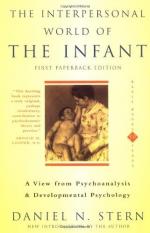
|
| Name: _________________________ | Period: ___________________ |
This test consists of 5 multiple choice questions, 5 short answer questions, and 10 short essay questions.
Multiple Choice Questions
1. The book states that affect attunement might truly have something to do with a process of ____________, which many mothers appear to be able to do.
(a) Mind-reading.
(b) Engagement.
(c) Active attunement.
(d) Sacred touch.
2. Children also begin to acquire a capacity to engage in _________ play, or the process of imitating the actions of adults in their lives.
(a) Maturing.
(b) Witness.
(c) Symbolic.
(d) Coloring.
3. Infants must understand the idea of __________, or their execution of the act and the ability to change between the two realities.
(a) Interaction.
(b) Perfection.
(c) Results.
(d) Reversibility.
4. By considering new experimental findings, Stern can begin to infer the _________ experience of the sense of self.
(a) Attunement.
(b) Quantitive.
(c) Subjective.
(d) Objective.
5. Attunement is often seen as a stepping stone to __________, according to some researchers.
(a) Language.
(b) Learning.
(c) Relationships.
(d) Connection.
Short Answer Questions
1. Sometimes equilibria form, but require a lot of ________ from others to maintain , according to Stern's findings.
2. However, other researchers have found that infants have optimum levels of __________ that they will seek and other levels they will avoid.
3. Non-__________ is a situation in which the infant is unable to engage in an attunement of affect, as in the case of being around a mentally unstable person.
4. Neurological and ethological viewpoints provide evidence that a sense of ______ is more sensitive during its formation.
5. Often, cases can be isolated according to particular senses of _________, which makes pathology easier to diagnose and to treat.
Short Essay Questions
1. What development has Stern's book sought to describe and to explore?
2. Why might pathologies result in the study of the formation of self in the infant, according to Stern?
3. What happens when a child reaches their second year of living, according to the book?
4. Why does Stern believe that the whole chain of reasoning that led to the idea of a barrier should be discarded?
5. As what does Stern hope for his work to serve within psychology and in the world, according to the content of the book?
6. What does it mean when the book says it is cross-modal and that it can cross sensory modalities?
7. What should psychopathology be seen as manifesting, according to the findings of Stern?
8. What does the development of the infant infer, according to Stern's findings?
9. What does Stern recognize about his theory, which he admits at the end of the book?
10. Why should the period of emergence of each sense of self be focused on when an infant is studied, according to the content of the book?
|
This section contains 620 words (approx. 3 pages at 300 words per page) |

|




